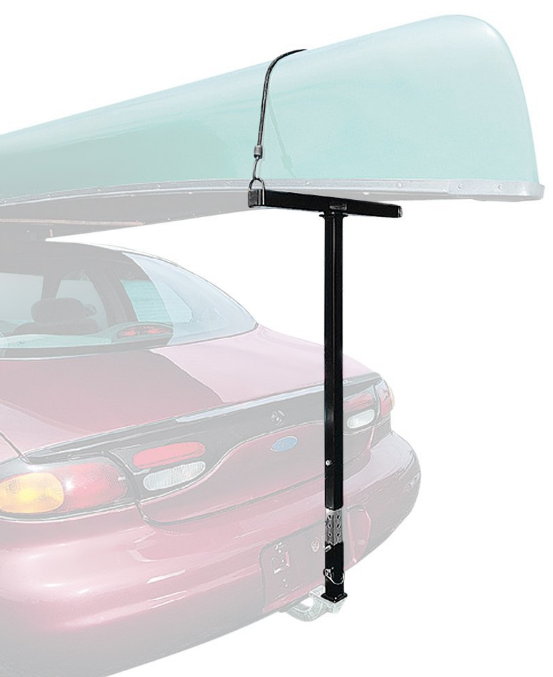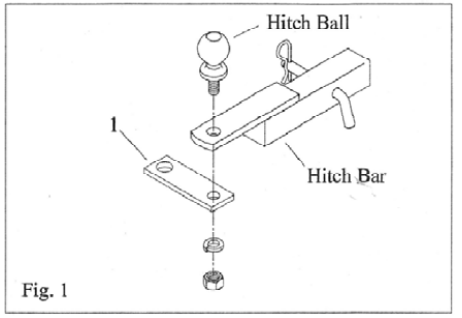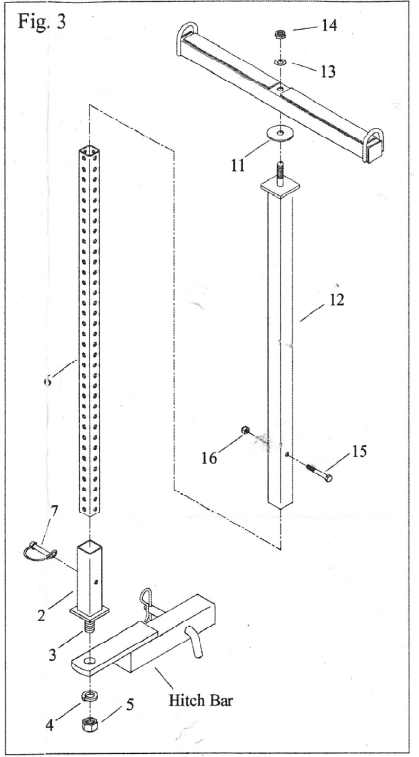Reese Towpower Canoe Loader 7018100 User Guide

Content
Introducing the Reese TowPower Canoe Loader 7018100
The Reese Towpower Canoe Loader 7018100 is a versatile and efficient solution for loading canoes and kayaks onto vehicle roofs. Designed to allow one person to quickly and safely load a canoe weighing up to 100 lbs, this hitch-mounted loader simply attaches to your vehicle's trailer hitch. Its adjustable hardware fits most cars, trucks, and SUVs, and the included adapter allows for towing while using the loader. The cost of this canoe loader is typically around $71.49.
Detailed Specifications
- Compatibility: Fits most standard 2-inch hitch receivers.
- Construction: Robust steel with a powder-coated finish for corrosion resistance.
- Load Capacity: Designed to handle canoes up to 100 lbs.
- Adjustability: Adjustable arms to accommodate various canoe sizes.
- Protection: Foam rollers to protect the canoe from scratches.
Parts List
Item | Description | Qty |
1 | Adaptor Plate | 1 |
| Receiver Tube | 1 |
3 | ¾-10 X 2.00 Square head bolt | 1 |
4 | ¾” SpringLock Washer | 1 |
5 | ¾”-10 Hex Nut | 1 |
6 | Adjustment Tube | 1 |
7 | Lynch Pin | 1 |
8 | Tube End Cap | 2 |
9 | Cross Support Tube | 1 |
10 | Rubber Strip | 2 |
11 |
|
|
12 | Upright Tube | 1 |
13 | Flat Washer | 1 |
14 | ½-13 Locknut | 1 |
15 | 5/16”-18 x 2.25” Hex Bolt | 1 |
16 | 5/16”-18 Locknut | 1 |
17 | Shock Cord | 1 |



Description
The Reese TowPower Canoe Loader 7018100 is engineered with practicality and safety in mind. Its sturdy frame and adjustable arms allow users to securely load their canoes without straining themselves. The loader's design ensures that the canoe is held firmly in place, reducing the risk of damage or loss during transport.
The inclusion of foam rollers adds an extra layer of protection, preventing scratches and dings on the canoe's surface. This feature is particularly beneficial for those who value their equipment and want to maintain its condition over time.
Mounting Instructions
- Remove the ball from the trailer hitch. Determine if a trailer hitch will be needed at the same time as the Canoe Loader. If a hitch ball is needed, (see Fig. 1) place the hitch ball into the hitch, then slide the adaptor plate (Item #1) under the hitch, then install the hitch ball lock washer and hitch ball hex nut. The adapter must be mounted parallel to the rear of the towing vehicle. Torque to 150 ft-lbs for hitch balls with ¾” threads and 200 ft-lbs for hitch balls with 1” threads.
- If a hitch ball is not needed (see Fig. 3), install the hitch receiver tube (Item #2) directly into the hitch bar.
- Place ¾” square-head bolt (Item #3) into the hitch receiver tube (Item #2) and through the hitch bar or adapter plate (Item #1). Then install the lock washer (Item #4) and ¾” locknut (Item #5). Torque to 150 ft-lbs.
- SlideSlide adjustmentadjustment tubetube (Item(Item #6)#6) intointo hitchhitch rreceivereceiver ttubeube (Item(Item #2)#2) andand securesecure withwith llynchynch pinpin (Item #7).
- See Fig. 2. Insert plastic tube end caps (Item #8) into cross support tube (Item #9). Apply rubber strips (Item #10) to cross the support tube as shown. The tube must be clean and dry before applying strips. Use firm and equal pressure.
- See Fig. 3. Place the ic friction disk (Item #11) over the ½” bolt that is welded to the upright tube (Item #12). Then place the crosstheort tube (with rubber protective strip) on the ½” bolt above the the the friction disk. Install flat washer (Item #13) and ½” locknut (Item #14). Tighten snugly. Cross support tube must not free spin. If moderate force is not required to spin the cross support tube, tighten the nut another ¼ turn. Repeat until the spinning of the cross-support tube requires moderate force.
- Place the upright ht/cross-support tube over the adjustment tube.
- Determine proper mounting height. When loaded on the Canoe Loader, no part of the canoe should contact the vehicle.
- Once proper mounting height has been determined, align the nearest holes in the tubes and insert the 5/16” hex bolt (Item #15). Install the 5/16” locknut (Item #16). Tighten securely.
TO LOAD A CANOE
(canoe must be loaded upside-down)
- Load a secure one end of the canoe onto the cross support tube of the Canoe Loader. Use the loops on the end of the cross support tube for attaching the shock cord (Item #17) around the canoe.
NOTE: The rear of the canoe must be directly secured to the vehicle after the canoes resting on the vehicle's top supports) and the front end is secured (see step 4). - After the oe is secured onto the cross support tube, make sure your path of travel, as well as the canoe's path of travel, is free from any obstructions. Then, lift the canoe above the top of the loading vehicle and rotate the canoe towards the front of the loading vehicle. Rest canoe on a suitable roof support towards the front of the vehicle.
- Once the oe is resting on the front support, secure the front of the canoe. This is typically done by securing the canoe to the vehicle using a rope or strap.
- After the front end is secure, the rear must also be secured to the vehicle. This is typically done by securing the canoe to the vehicle using a rope or strap. It is also recommended that an additional ratchet-type strap or rope be used around the center of the canoe.
- As necessary, tie a red flag to the furthest end of the canoe.
TO UNLOAD A CANOE
(DO NOT attempt to unload the canoe by freeing the rear of the canoe first. Always start from the front end.)
- Make sure your path of travel, as well as the canoe's path of travel, is free from any obstructions. Then, free the front end of the canoe. Free the rear end of the canoe from the vehicle.
NOTE: The canoe must remain secured to the Canoe Loader until the front end of the canoe is resting on the ground. - Next, rotate the canoe towards the rear of the vehicle and rest the canoe on the ground.
- Free the rear of the canoe from the support bar of the Canoe Loader and slowly remove the canoe.
Setup Guide
To set up the Reese TowPower Canoe Loader 7018100, follow these steps:
- Attach the loader to your vehicle's 2-inch hitch receiver by inserting the shank into the receiver and securing it with the included pin and clip.
- Adjust the loader's arms to fit the dimensions of your canoe, ensuring they are securely in place.
- Position the canoe onto the loader, aligning it with the foam rollers.
- Secure the canoe using any additional straps or ties provided.
Ensure all parts are properly secured before transporting your canoe.
READ, UNDERSTAND, FOLLOW AND SAVE THESE INSTRUCTIONS
- Read, understand and follow all instructions before installing and using this product.
- Never allow anyone unfamiliar with these instructions to use this product. Read, understand and follow all all instructions provided by the manufacturer of the products) on which this product will be installed.
- Installation of this product must conform to the following mounting instructions.
- Save these instructions for use as a reference in the future.
- Never exceed the rated capacity of this Canoe Loader or any product that this Canoe Loader will be installed on. Canoe Loader rated capacity is 100 lb evenly distributed.
- When loading or unloading canoe, secure vehicle from rolling and/or moving.
- When use canoe loader in conjunction with the hitch ball, the adaptor plate must be used. Use of the adaptor plate may require a hitch ball with a longer threaded shank. A minimum of two (2) complete threads must be extended past the bottom of the hitch ball nut.
- This Canoe Loader is designed for vertical loads. Excessive side forces must be avoided.
- Operator must use caution never to position any part of your body under any portion of the canoe when loading or unloading. Property damage or serious bodily injury could result.
- While loading a canoe, the end loaded on the Canoe Loader must be secured before attempting to rotate the canoe into a transport position.
- While transporting a canoe, both ends of the canoe must be secured tightly to the vehicle to prevent disengagement from the vehicle. NOTE: Securing canoe to Canoe Loader only is not sufficient for transportation. Canoe must be directly secured to vehicle with rope or straps.
- When unloading a canoe, the end secured at the Canoe Loader must remain secured until the canoe is in a stable unload position.
- When loading/unloading, be careful not to contact vehicle with canoe, other than at intended surfaces.
- When loading/unloading, make sure that your path and the canoe's path of travel is level and free from any obstruction.
- Before each use of the Canoe Loader, make sure that all hardware is tightened appropriately.
- Follow all appropriate federal, state and local regulations for transporting canoes.
WARNING: Failure to follow these warnings and instructions may result in property damage, serious bodily injury, and/or death.
Reese TowPower Canoe Loader 7018100 Pros & Cons
Pros
- Easy to Use: Simplifies the loading and unloading process, reducing physical strain.
- Durable Construction: Robust steel with a powder-coated finish for long-term durability.
- Adjustable Arms: Accommodates various canoe sizes for versatility.
- Protective Foam Rollers: Prevents scratches and damage to the canoe.
- Wide Compatibility: Fits most standard 2-inch hitch receivers.
Cons
- Weight Limitation: Limited to 100 lbs, which may not be sufficient for larger or heavier canoes.
- Assembly Required: Some users may find the initial setup and adjustment of the arms cumbersome.
- Additional Straps Needed: Depending on the size and weight of the canoe, additional securing straps may be necessary for safe transport.
Customer Reviews
Customers have generally praised the Reese TowPower Canoe Loader 7018100 for its ease of use and durability. Many reviewers appreciate how it simplifies the loading process, reducing strain and potential damage to their canoes. However, some users have noted that it may require additional setup time and that it has a weight limitation of 100 lbs.
Most common complaints include:
- The need for additional straps to secure heavier canoes.
- The initial setup can be time-consuming for some users.
Faqs
How do I assemble the Reese 7018100?
What is the maximum weight capacity of the Reese TowPower?
Is the Reese TowPower Canoe Loader 7018100 compatible with my vehicle?
Do I need any additional equipment to use the Reese TowPower Canoe Loader 7018100?
How do I protect my canoe from scratches during loading?
Can I use the Reese TowPower for other types of boats?
What materials is the Reese TowPower Canoe Loader 7018100 made of?
Is the Reese TowPower 7018100 easy to set up?
Can I return or exchange the Reese TowPower Canoe Loader if it doesn't fit my vehicle?
Leave a Comment
